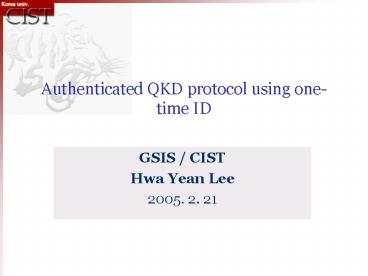Authenticated QKD protocol using onetime ID - PowerPoint PPT Presentation
1 / 16
Title:
Authenticated QKD protocol using onetime ID
Description:
Authenticated QKD protocol using one-time ID. GSIS / CIST. Hwa Yean Lee. 2005. 2. 21 ... Miloslav Dusek, Ondrej Haderka, Martin Hendrych, and Robert Myska, PRA, ... – PowerPoint PPT presentation
Number of Views:69
Avg rating:3.0/5.0
Title: Authenticated QKD protocol using onetime ID
1
Authenticated QKD protocol using one-time ID
- GSIS / CIST
- Hwa Yean Lee
- 2005. 2. 21
2
Contents
- Introduction
- Authentication with one-time ID
- Quantum Key distribution
- Security proof
- Conclusion
3
1. Introduction
- QKD (Quantum Key Distribution) protocols
- Advantage
- Unconditional security
- Disadvantage
- Vulnerability to the Man-in-the middle
attack
4
1. Introduction(2)
- Miloslav Dusek, Ondrej Haderka, Martin Hendrych,
and Robert Myska, PRA, 60, 149-156 (1999) - Bao-Sen Shi, Jian Li, Jin-Ming Liu, Xiao-Feng
Fan, Guang-Can Guo, Physics Letters A 281 83-87
(2001) - Guihua Zeng and Weiping Zhan, PRA, 61, 022303
(2000) - Daniel Ljunggren, Mohamed Bourennane, and Anders
Karlsson, PRA, 62, 022305 (2000) - Takashi Mihara, PRA, 65, 052326 (2002)
5
2. Authentication with one-time ID
- Preparation
- Each user register him to the arbitrator
- secret user and one-way function
- One-way authentication key of a user, Alice is
- where is a count.
- If is 1, then the Hadamard operator
is applied, else the identity operator is
applied to the ith qubit. - If does not have enough length to
encode the qubits, then can be
used, where .
6
2. Authentication with one-time ID (2)
- Procedure of the authentication
- Alice request a secure communication with Bob to
the arbitrator. - The arbitrator prepares GHZ tripartite
states. - He encodes Alices and Bobs particles of GHZ
states with and ,
respectively. - where is Alices authentication
key - and is Bobs.
7
2. Authentication with one-time ID (3)
- Procedure of the authentication(2)
- The arbitrator sends the encoded qubits to Alice
and Bob respectively. - Alice and Bob decode their qubits with their
authentication key and selects some bits. - Alice and Bob measure the bits and compare the
results. - If the results are same, they can authenticate
each other and do the following key distribution
procedure. Otherwise they abort the protocol.
8
2. Authentication with one-time ID (4)
- Transformation of the GHZ states
9
3. Quantum Key distribution
- Procedure of the key distribution
- Using the remaining particles after
authentication, Alice and Bob randomly make an
operation either or on each particles,
respectively. - Alice sends her particles to the arbitrator and
Bob sends his to Alice. - The arbitrator perform C-NOT operation, where the
control qubit is his and the target qubits is
from Alice. - The arbitrator measures each qubits(Alices and
his) and announces the measurement outcomes are
same(O) or not(X).
10
3. Quantum Key distribution (2)
- Procedure of the key distribution (2)
- Alice measures the GHZ particles received from
Bob. - Using the information published by the
arbitrator, Alice can find Bobs sequence of the
operations. - The Bobs sequence of the operations can be used
as a raw secret key.
11
3. Quantum Key distribution (3)
12
4. Security proof
- Man-in-the middle attack
- In the authentication process
- Eve introduces errors
- with probability ¼
- for each check bit
- in the authentication
- procedure.
- On knowing
- the hash function,
- Eve can estimate only
- some bits of hashed value.
13
4. Security proof (2)
- Intercept-resend attack
- Intercepts both the qubits heading to Alice or
Bob in the authentication and the qubits heading
to Alice or the authentication in the key
distribution. - When Eve intercepts one-side in the key
distribution, - the probability of detection is 3/8.
- When Eve intercepts both-side in the key
distribution, - the probability of detection is 7/16.
- But she cannot be aware of the exact key since
Alice and Bobs information of operations are not
exposed to Eve.
14
4. Security proof (3)
- Intercept-resend attack (2)
- Intercept only the qubits transmitted in the key
distribution - Eve only can know Alice and Bob use same
operation or not. - The probability of inferring correct key is
.
15
4. Security proof (4)
- Eve Eavesdrops Alices (Bobs) qubits
transmitted to the arbitrator (Alice) after Alice
and Bob make operations on decoded GHZ states
16
5. Conclusion
- QKD with authentication using one-time ID is
proposed. - Authentication with one-time ID can be used on
the various fields of quantum cryptography. - The neutrality of the arbitrator is important
for the security of the proposed scheme. - ? More research on this problem are needed.































